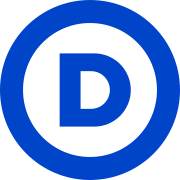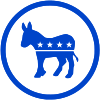
Back تاريخ الحزب الديمقراطي للولايات المتحدة Arabic Histoire du Parti démocrate French Storia del Partito Democratico (Stati Uniti d'America) Italian アメリカ合衆国民主党の歴史 Japanese 민주당 (미국)의 역사 Korean
Democratic Party | |
|---|---|
 | |
| Chairperson | Jaime Harrison |
| Governing body | Democratic National Committee[1][2] |
| Founders | Andrew Jackson Martin Van Buren |
| Founded | January 8, 1828[3] |
| Preceded by | |
| Headquarters | 430 South Capitol St. SE, Washington, D.C., 20003 |
| Membership (2023) | |
| Ideology | American liberalism[5][6][7] |
| Political position | Big tent[21][22] |
| Colors | Blue (since 2000) |
| Election symbol | |
 [23] [23] | |
| Website | |
| democrats.org | |
The Democratic Party is one of the two major political parties of the United States political system and the oldest active political party in the country as well as in the world. The Democratic party was founded in 1828.[24][25][26] It is also the oldest active voter-based political party in the world. The party has changed significantly during its nearly two centuries of existence. Once known as the party of the "common man," the early Democratic Party stood for individual rights and state sovereignty, and opposed banks and high tariffs. In the first decades of its existence, from 1832 to the mid-1850s (known as the Second Party System), under Presidents Andrew Jackson, Martin Van Buren, and James K. Polk, the Democrats usually bested the opposition Whig Party by narrow margins.
Before the American Civil War, the party generally supported slavery or insisted it be left to the states. After the war until the 1940s, the party opposed civil rights reforms in order to retain the support of Southern white voters. The Republican Party was organized in the mid-1850s from the ruins of the Whig Party and Free Soil Democrats. It was dominant in presidential politics from 1860 to 1928. The Democrats elected only two Presidents during this period: Grover Cleveland (in 1884 and 1892) and Woodrow Wilson (in 1912 and 1916). Over the same period, the Democrats proved more competitive with the Republicans in Congressional politics, enjoying House of Representatives majorities (as in the 65th Congress) in 15 of the 36 Congresses elected owing largely to their dominance of the Solid South, although only in five of these did they form the majority in the Senate. Furthermore, the Democratic Party was split between the Bourbon Democrats, representing Eastern business interests, and the agrarian party elements representing poor farmers in the South and West. After the Republican landslide in the 1894 House Elections, the agrarian element, marching behind the slogan of free silver (i.e. in favor of inflation), captured the party. They nominated William Jennings Bryan in the 1896, 1900 and 1908 presidential elections, although he lost every time. Both Bryan and Wilson were leaders of the progressive movement in the United States (1890s–1920s) and opposed imperialistic expansion abroad while sponsoring liberal reforms at home despite supporting racism and discrimination against African Americans in government offices and elsewhere.
Starting with 32nd President Franklin D. Roosevelt, the party dominated during the Fifth Party System, which lasted from 1932 until about the 1970s. In response to the Wall Street Crash of 1929 and the ensuing Great Depression, the party employed liberal policies and programs with the New Deal coalition to combat financial crises and emergency bank closings, with policies continuing into World War II. The Party kept the White House after Roosevelt's death in April 1945, reelecting former Vice President Harry S. Truman in 1948. During this period, the Republican Party only elected one president (Eisenhower in 1952 and 1956) and was the minority in Congress all but twice (the exceptions being 1946 and 1952). Powerful committee chairmanships were awarded automatically on the basis of seniority, which gave power especially to long-serving Southerners. Important Democratic leaders during this time included Presidents Harry S. Truman (1945–1953), John F. Kennedy (1961–1963) and Lyndon B. Johnson (1963–1969). Republican Richard Nixon won the White House in 1968 and 1972, leading to the end of the New Deal era.
Democrats have won six out of the last twelve presidential elections, winning in the presidential elections of 1976 (with 39th President Jimmy Carter, 1977–1981), 1992 and 1996 (with 42nd President Bill Clinton, 1993–2001), 2008 and 2012 (with 44th President Barack Obama, 2009–2017), and 2020 (with 46th President Joe Biden, 2021–present). Democrats have also won the popular vote in 2000 and 2016, but lost the Electoral College in both elections (with candidates Al Gore and Hillary Clinton, respectively). These were two of the four presidential elections in which Democrats won the popular vote but lost the Electoral College, the others being the presidential elections in 1876 and 1888.
- ^ "About the Democratic Party". Democratic Party. Archived from the original on April 6, 2022. Retrieved April 15, 2022.
For 171 years, [the Democratic National Committee] has been responsible for governing the Democratic Party
- ^ Democratic Party (March 12, 2022). "The Charter & The Bylaws of the Democratic Party of the United States" (PDF). p. 3. Archived (PDF) from the original on March 27, 2022. Retrieved April 15, 2022.
The Democratic National Committee shall have general responsibility for the affairs of the Democratic Party between National Conventions
- ^ Despite this date, the party claims an earlier formation date as noted in S.2047 which passed in the Democratic-controlled United States Senate in 1991.102nd Congress (1991), S.2047 – A bill to establish a commission to commemorate the bicentennial of the establishment of the Democratic Party of the United States.
{{citation}}: CS1 maint: numeric names: authors list (link) "[I]n 1992, the Democratic Party of the United States will celebrate the 200th anniversary of its establishment on May 13, 1792." - ^ Winger, Richard (December 29, 2023). "December 2023 Ballot Access News Print Edition". Ballot Access News. Archived from the original on December 28, 2022. Retrieved January 9, 2024.
- ^ Center, Pew Research (November 9, 2021). "Beyond Red vs. Blue: The Political Typology". Pew Research Center - U.S. Politics & Policy. Retrieved March 8, 2024.
- ^ Inc, Gallup (January 12, 2023). "Democrats' Identification as Liberal Now 54%, a New High". Gallup.com. Retrieved March 8, 2024.
{{cite web}}:|last=has generic name (help) - ^ "Have Democrats become a party of the left?". Brookings. Retrieved March 8, 2024.
- ^ Arnold, N. Scott (2009). Imposing values: an essay on liberalism and regulation. Oxford University Press. p. 3. ISBN 9780495501121. Archived from the original on October 2, 2020. Retrieved April 28, 2020.
Modern liberalism occupies the left-of-center in the traditional political spectrum and is represented by the Democratic Party in the United States.
- ^ "President Obama, the Democratic Party, and Socialism: A Political Science Perspective". The Huffington Post. June 29, 2012. Archived from the original on March 24, 2019. Retrieved January 9, 2015.
- ^ Hale, John (1995). The Making of the New Democrats. New York: Political Science Quarterly. p. 229.
- ^ Dewan, Shaila; Kornblut, Anne E. (October 30, 2006). "In Key House Races, Democrats Run to the Right". The New York Times. Archived from the original on July 27, 2019. Retrieved January 28, 2017.
- ^ Irwin, Lauren (October 13, 2023). "Democratic centrists offer to back McHenry as temporary House leader".
- ^ "Centrist Democrats target Lauren Boebert and Derrick Van Orden in 2024".
- ^ Stein, Letita; Cornwell, Susan; Tanfani, Joseph (August 23, 2018). "Inside the progressive movement roiling the Democratic Party". Reuters. Archived from the original on June 13, 2022. Retrieved June 13, 2022.
- ^ Trudo, Hanna (August 26, 2023). "Progressives see promise in more diverse candidates, voters ahead of 2024".
- ^ "Progressives focus on local-level wins to reshape Democratic Party from the bottom up". PBS NewsHour. April 17, 2023.
- ^ Greve, Joan E. (November 9, 2022). "Progressive candidates score crucial wins in midterm elections". The Guardian.
- ^ Ball, Molly. "The Battle Within the Democratic Party". The Atlantic. Archived from the original on June 12, 2018. Retrieved January 28, 2017.
- ^ Chotiner, Isaac (March 2, 2020). "How Socialist Is Bernie Sanders?". The New Yorker. Archived from the original on January 12, 2021. Retrieved February 14, 2021.
- ^ Bacon, Perry Jr. (March 11, 2019). "The Six Wings Of The Democratic Party". FiveThirtyEight. Archived from the original on August 15, 2021. Retrieved October 21, 2021.
- ^ Dautrich, Katherine (November 1, 2023). "Analysis: Democrats' big tent includes most Jewish and Muslim Americans | CNN Politics". CNN. Retrieved March 8, 2024.
- ^ "Democrats have considered their party to be a big tent. Does it have holes in it?". NPR. March 6, 2024.
- ^ "Democratic Party | History, Definition, & Beliefs". May 17, 2023.
- ^ Witcover, Jules (2003), "Chapter 1", Party of the People: A History of the Democrats
- ^ Micklethwait, John; Wooldridge, Adrian (2004). The Right Nation: Conservative Power in America. p. 15. "The country possesses the world's oldest written constitution (1787); the Democratic Party has a good claim to being the world's oldest political party."
- ^ Janda, Kenneth; Berry, Jeffrey M.; Goldman, Jerry (2010). The Challenge of Democracy: American Government in Global Politics. Cengage Learning. p. 276. ISBN 978-0-495-90618-6.
© MMXXIII Rich X Search. We shall prevail. All rights reserved. Rich X Search